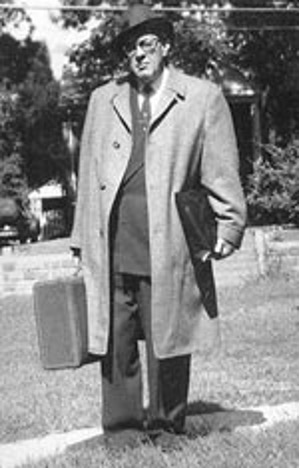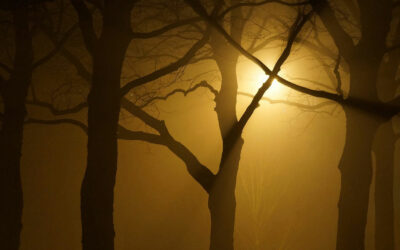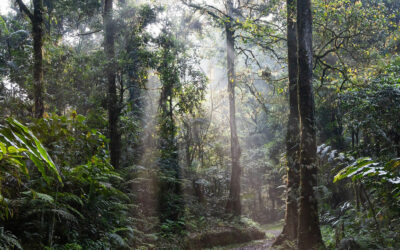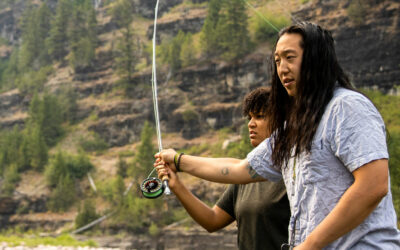The McKenzie River in Central Oregon. Photo credit: Pixabay
Wilderness Perspectives: Zahniser’s Support for the Authentic Wilderness Experience
Stewardship
June 2023 | Volume 29, Number 1
When many of us picture Howard Zahniser, we think of one image. With a focused look on his face, we see Zahnie looking directly into the camera in his backyard in Hyattsville, Maryland, wearing a custom-tailored suitcoat. On the outside, the coat is unremarkable. But, under its outer layer, it speaks volumes. Zahnie’s Georgetown tailor, E. Sye Silas, modified the coat to include multiple oversized pockets that were often filled with information on the wilderness bill that Zahnie would share with lawmakers on the Hill. While this iconic image reminds us that Zahnie was, in the words of David Brower, “the constant advocate” of the wilderness bill and a deft and tireless Washington lobbyist, it obscures that, inside, his wilderness thinking was also profound, multidimensional, and big. When he thought of the authentic wilderness experience, he did not simply mean the passive observation of nature in a regimented wilderness area. For him, it was more than that.
Zahnie’s dedication to the passage of the wilderness bill was rooted in providing opportunities for an authentic experience based, in part, on wilderness’s capacity to foster intimate connections with the natural world. He felt that experiencing wilderness could lead to a “humility to know ourselves as the dependent members of a great community of life” (Zahniser 1957, p. 200). Expanding on this, he critiqued modern humans as “less and less aware of their dependance on other forms of life and more and more misled into a sense of self-sufficiency and into a disregard of their interdependence with the other forms of life with which they – together – derive their existence form the solar center of the universe” (Zahniser 1957, p. 201). This is not language typically associated with the bureaucratese of Washington lobbyists and is an attempt, I think, to capture the impact of authentic wilderness experiences.

Figure 1 – Howard Zahniser. Courtesy of wilderness.net.
As the readers of this journal know, regulations can sometimes be implemented to limit the number of people allowed in a wilderness area – or prespecified zones in an area – at one time. Such limited-entry areas are becoming more common, such as the establishment of the Central Cascades Wilderness Permit system, which limits both day and overnight use in the Mt. Jefferson, Mt. Washington, and Three Sisters Wilderness areas. Although these actions may be needed to properly steward wilderness, further administrative changes may also be needed to ensure opportunities for an authentic wilderness experience as such limits are established. Looking back into history can help us determine what may be necessary.
In the first hearing of the wilderness bill in 1957, Zahniser briefly discussed a report from the Library of Congress’s Legislative Reference Service. In 1948, members of Congress had requested this study by Charles Frank Keyser to provide background for potential legislative action on wilderness designation, which was prompted by Zahniser’s lobbying (Congressional Quarterly 1964). This report sheds light on postwar thoughts on wilder- ness and the wilderness experience and is a valuable, and often overlooked, piece of wilderness history. Zahniser’s response to Keyser’s survey was briefly discussed at the hearings, and The Wilderness Society’s original and unaltered response to it was entered as evidence by Zahniser in 1957 during the first hearings on the National Wilderness Preservation Act (Zahniser 1957; Zahniser 1949).

Figure 2 – Howard Zahniser. From the Conservation Collection in the Genealogy, African American and Western History Library at the Denver Public Library.
Keyser’s survey asked many open-ended questions, including, “What do you consider permissible uses of wilderness areas?” Zahnie’s response has clear implications for current management, such as limited-entry areas:
Eventually it may be that wilderness use will have to be rationed. This would seem to be the alternative to administering the wilderness for the accommodations of large numbers of people at a time, which would jeopardize the wilderness itself and the wilderness “atmosphere” and at the same time would require regulation or regimentation of the visitors in such a way is to destroy “the freedom of the wilderness” and to nullify the escape from restrictions that is so important a part of the wilderness experience (Zahniser 1957, p. 193)
Later in the survey, Zahnie takes the perspective of a wilderness manager and describes the managerial dilemma of limiting “the numbers of users at any one time or surround users with such restrictions as are required in ‘crowded’ natural areas of parks.” To him, the “true wilderness choice seems certain to be the limitation of numbers of users of such an area at a time, on the basis of preserving not only the wilderness but also the authenticity of the wilderness experience” (Zahniser 1957, p. 194).
“As we conjure images of Zahnie, we should both appreciate the image of a lobbyist with complex and multidimensional meaning obscured by a tailored suit as well as a wilderness visitor deep in thought and reflection about humans’ role in a more-than-human world.”
It seems certain that Zahnie would support modifying restrictions in newly established limited- entry areas to ensure the “authenticity” of the wilderness experience in its preservation of the “freedom of the wilderness.” Thus, if our stewardship of wilderness areas and the wilderness experience is to be informed by the act’s chief architect, wilderness managers could modify and loosen direct restrictions (e.g., mandatory camping setbacks from water and trails fire restrictions) in areas where they limit the numbers of wilderness visitors allowed at one time. Such a proposal would ideally preserve the opportunity for an authentic wilderness experience that is relatively unencumbered by the regimentation of rules and regulations that can confine the wilderness visitor.
In this light, we return to a different and largely ignored image of Zahnie. His custom-tailored suit is absent and he’s sitting on an unknown trail. He’s unshaven and unaware of the camera, writing and seemingly deep in thought. Such an image complicates the caricaturized narrative of Zahnie as only a Washington lobbyist. Like other wilderness champions before him, he was deeply engaged with the natural world and, to him, an unconfined, and thus authentic, wilder- ness experience was one that could facilitate humans’ felt understanding that we, along with nonhuman nature, are “dependent members of an interdependent community of living creatures that together derive their existence from the sun” (Zahniser 1957, p. 199). Thus, as we conjure images of Zahnie, we should both appreciate the image of a lobbyist with complex and multi- dimensional meaning obscured by a tailored suit as well as a wilderness visitor deep in thought and reflection about humans’ role in a more-than-human world.
About the Author
JESSE ENGEBRETSON is an assistant professor in the Department of Recreation, Hospitality, and Parks Management at California State University, Chico: email: jengebretson@csuchico.edu
References
Congressional Quarterly. 1964. Congressional Quarterly Almanac, 88th Congress, 2nd Session. Washington, DC: Congressional Quarterly News Features.
Zahniser, H. 1957. National Wilderness Preservation Act: Hearings before the Committee on Interior and Insular Af- fairs on S. 1176, 85th Cong. 152-275 (testimony of Howard Zahniser).
Zahniser, H. 1949. Legislative Reference Service, Wilderness Society statement. The Wilderness Society Records (Series 2, Box 21, File 8). Archives of the Conservation Collection, Denver Public Library, Denver, CO.
Read Next
Unseen Forces Still Wild
Between the precincts of Amun-Re and Montu in the vast Egyptian temple complex of Karnak is a dark little room permitting only a single shaft of sun- or moonlight to enter.
Kathy MacKinnon
A Smart, Dedicated, Accomplished, and Compassionate Conservationist
Can We Make Wilderness More Welcoming?
An Assessment of Barriers to Inclusion



